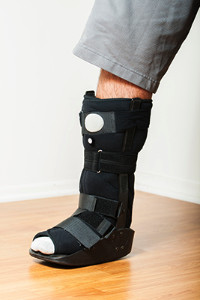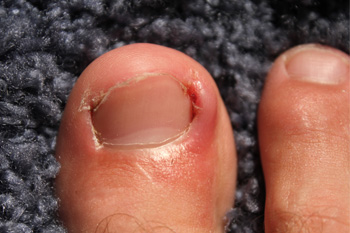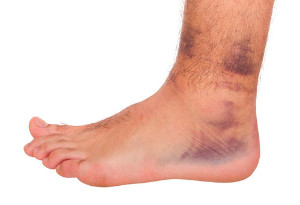February 2020
The Bones in the Feet May Fracture Easily
 Each foot is comprised of 26 bones. Many of these bones are small, and can easily be fractured. This can happen as a result of a heavy object falling on the foot, or if it is stubbed against a piece of furniture. Common symptoms of a broken foot will generally consist of pain that is so intense, walking may be difficult. Additionally, the foot may appear red and bruised. In severe breaks, the bone may be protruding through the skin. After a proper diagnosis is performed, which typically consists of having an X-ray taken, proper treatment can begin. This can include wearing a supportive boot or cast for several weeks as the healing process takes place. If you feel you have broken bones in your foot, it is advised that you schedule a consultation with a podiatrist as quickly as possible who can determine the best course of treatment for you.
Each foot is comprised of 26 bones. Many of these bones are small, and can easily be fractured. This can happen as a result of a heavy object falling on the foot, or if it is stubbed against a piece of furniture. Common symptoms of a broken foot will generally consist of pain that is so intense, walking may be difficult. Additionally, the foot may appear red and bruised. In severe breaks, the bone may be protruding through the skin. After a proper diagnosis is performed, which typically consists of having an X-ray taken, proper treatment can begin. This can include wearing a supportive boot or cast for several weeks as the healing process takes place. If you feel you have broken bones in your foot, it is advised that you schedule a consultation with a podiatrist as quickly as possible who can determine the best course of treatment for you.
A broken foot requires immediate medical attention and treatment. If you need your feet checked, contact Dr. Lee R. Stein from Lake Shore Foot & Ankle, PC. Our doctor can provide the care you need to keep you pain-free and on your feet.
Broken Foot Causes, Symptoms, and Treatment
A broken foot is caused by one of the bones in the foot typically breaking when bended, crushed, or stretched beyond its natural capabilities. Usually the location of the fracture indicates how the break occurred, whether it was through an object, fall, or any other type of injury.
Common Symptoms of Broken Feet:
- Bruising
- Pain
- Redness
- Swelling
- Blue in color
- Numbness
- Cold
- Misshapen
- Cuts
- Deformities
Those that suspect they have a broken foot shoot seek urgent medical attention where a medical professional could diagnose the severity.
Treatment for broken bones varies depending on the cause, severity and location. Some will require the use of splints, casts or crutches while others could even involve surgery to repair the broken bones. Personal care includes the use of ice and keeping the foot stabilized and elevated.
If you have any questions please feel free to contact one of our offices located in Chicago, Highland Park, and Uptown, IL . We offer the newest diagnostic and treatment technologies for all your foot and ankle needs.
Do I Have An Ingrown Toenail?
 The toe that is most likely to develop an ingrown toenail is the big toe. An ingrown toenail is defined as the corner of the nail growing into the surrounding skin, which can cause severe pain and discomfort. It may happen as a result of wearing shoes that do not provide enough room for the toes to move freely in, or from trimming the toenails too short and incorrectly. Some people are born with irregular or curved toenails, and this may increase the probability of developing an ingrown toenail. Common symptoms that are often associated with this condition can include red and tender skin surrounding the affected nail, and fluid may drain from the area. If you are afflicted with an ingrown toenail, it is strongly advised that you are under the care of a podiatrist who can offer you correct treatment options.
The toe that is most likely to develop an ingrown toenail is the big toe. An ingrown toenail is defined as the corner of the nail growing into the surrounding skin, which can cause severe pain and discomfort. It may happen as a result of wearing shoes that do not provide enough room for the toes to move freely in, or from trimming the toenails too short and incorrectly. Some people are born with irregular or curved toenails, and this may increase the probability of developing an ingrown toenail. Common symptoms that are often associated with this condition can include red and tender skin surrounding the affected nail, and fluid may drain from the area. If you are afflicted with an ingrown toenail, it is strongly advised that you are under the care of a podiatrist who can offer you correct treatment options.
Ingrown toenails can become painful if they are not treated properly. For more information about ingrown toenails, contact Dr. Lee R. Stein of Lake Shore Foot & Ankle, PC. Our doctor can provide the care you need to keep you pain-free and on your feet.
Ingrown Toenails
Ingrown toenails occur when a toenail grows sideways into the bed of the nail, causing pain, swelling, and possibly infection.
Causes
- Bacterial infections
- Improper nail cutting such as cutting it too short or not straight across
- Trauma to the toe, such as stubbing, which causes the nail to grow back irregularly
- Ill-fitting shoes that bunch the toes too close together
- Genetic predisposition
Prevention
Because ingrown toenails are not something found outside of shoe-wearing cultures, going barefoot as often as possible will decrease the likeliness of developing ingrown toenails. Wearing proper fitting shoes and using proper cutting techniques will also help decrease your risk of developing ingrown toenails.
Treatment
Ingrown toenails are a very treatable foot condition. In minor cases, soaking the affected area in salt or antibacterial soaps will not only help with the ingrown nail itself, but also help prevent any infections from occurring. In more severe cases, surgery is an option. In either case, speaking to your podiatrist about this condition will help you get a better understanding of specific treatment options that are right for you.
If you have any questions please feel free to contact one of our offices located in Chicago, Highland Park, and Uptown, IL . We offer the newest diagnostic and treatment technologies for all your foot and ankle needs.
It's Time for Beautiful Feet
Swollen Feet During Pregnancy
 Foot conditions are generally a common ailment among pregnant women. The weight from increased blood volume, as well as the growing fetus, may cause the feet to become flat, which can produce sharp or aching pains. Moderate relief may be found when shoes that are worn fit properly. To ensure a perfect fit and for extra support, it may help to wear custom-made orthotics. Additionally, swollen feet and ankles are a common ailment among pregnant patients, and can be uncomfortable. It is beneficial to elevate the feet frequently during the day, as this may help to reduce existing swelling. Some pregnant women experience ingrown toenails, which may be a result of changes in the size and shape of the toenail. If you would like more information about how your feet may be affected during pregnancy, it is recommended that you consult with a podiatrist.
Foot conditions are generally a common ailment among pregnant women. The weight from increased blood volume, as well as the growing fetus, may cause the feet to become flat, which can produce sharp or aching pains. Moderate relief may be found when shoes that are worn fit properly. To ensure a perfect fit and for extra support, it may help to wear custom-made orthotics. Additionally, swollen feet and ankles are a common ailment among pregnant patients, and can be uncomfortable. It is beneficial to elevate the feet frequently during the day, as this may help to reduce existing swelling. Some pregnant women experience ingrown toenails, which may be a result of changes in the size and shape of the toenail. If you would like more information about how your feet may be affected during pregnancy, it is recommended that you consult with a podiatrist.
Pregnant women with swollen feet can be treated with a variety of different methods that are readily available. For more information about other cures for swollen feet during pregnancy, consult with Dr. Lee R. Stein from Lake Shore Foot & Ankle, PC. Our doctor will attend to all of your foot and ankle needs.
What Foot Problems Can Arise During Pregnancy?
One problem that can occur is overpronation, which occurs when the arch of the foot flattens and tends to roll inward. This can cause pain and discomfort in your heels while you’re walking or even just standing up, trying to support your baby.
Another problem is edema, or swelling in the extremities. This often affects the feet during pregnancy but tends to occur in the later stages.
How Can I Keep My Feet Healthy During Pregnancy?
- Wearing orthotics can provide extra support for the feet and help distribute weight evenly
- Minimize the amount of time spent walking barefoot
- Wear shoes with good arch support
- Wear shoes that allow for good circulation to the feet
- Elevate feet if you experience swelling
- Massage your feet
- Get regular, light exercise, such as walking, to promote blood circulation to the feet
If you have any questions please feel free to contact one of our offices located in Chicago, Highland Park, and Uptown, IL . We offer the newest diagnostic and treatment technologies for all your foot and ankle needs.
How Do Ankle Sprains Occur?
A common injury that is known as an ankle sprain can occur as a result of suddenly twisting the ankle. The ligaments in the ankle can become stretched beyond normal limitations, and can happen from participating in sporting activities, or from stepping on uneven pavement. This type of injury often produces severe pain and discomfort, and can inhibit the ability to walk. Additional symptoms can include swelling and bruising surrounding the affected area, and it may be difficult to bend the ankle. After a proper diagnosis is performed, which often consists of having an X-ray taken, the correct treatment can begin. If you have sprained your ankle, it is strongly suggested that you consult with a podiatrist who can guide you toward the correct treatment techniques.
Ankle sprains are common but need immediate attention. If you need your feet checked, contact Dr. Lee R. Stein from Lake Shore Foot & Ankle, PC. Our doctor can provide the care you need to keep you pain-free and on your feet.
How Does an Ankle Sprain Occur?
Ankle sprains take place when the ligaments in your ankle are torn or stretched beyond their limits. There are multiple ways that the ankle can become injured, including twisting or rolling over onto your ankle, putting undue stress on it, or causing trauma to the ankle itself.
What Are the Symptoms?
- Mild to moderate bruising
- Limited mobility
- Swelling
- Discoloration of the skin (depending on severity)
Preventing a Sprain
- Wearing appropriate shoes for the occasion
- Stretching before exercises and sports
- Knowing your limits
Treatment of a Sprain
Treatment of a sprain depends on the severity. Many times, people are told to rest and remain off their feet completely, while others are given an air cast. If the sprain is very severe, surgery may be required.
If you have suffered an ankle sprain previously, you may want to consider additional support such as a brace and regular exercises to strengthen the ankle.
If you have any questions please feel free to contact one of our offices located in Chicago, Highland Park, and Uptown, IL . We offer the newest diagnostic and treatment technologies for all your foot and ankle needs.
Blog Archives
- April 2025
- March 2025
- February 2025
- January 2025
- December 2024
- November 2024
- October 2024
- September 2024
- August 2024
- July 2024
- June 2024
- May 2024
- April 2024
- March 2024
- February 2024
- January 2024
- December 2023
- November 2023
- October 2023
- September 2023
- August 2023
- July 2023
- June 2023
- May 2023
- April 2023
- March 2023
- February 2023
- January 2023
- December 2022
- November 2022
- October 2022
- September 2022
- August 2022
- July 2022
- June 2022
- May 2022
- April 2022
- March 2022
- February 2022
- January 2022
- December 2021
- November 2021
- October 2021
- September 2021
- August 2021
- July 2021
- June 2021
- May 2021
- April 2021
- March 2021
- February 2021
- January 2021
- December 2020
- November 2020
- October 2020
- September 2020
- August 2020
- July 2020
- June 2020
- May 2020
- April 2020
- March 2020
- February 2020
- January 2020
- December 2019
- November 2019
- October 2019
- September 2019
- August 2019
- July 2019
- June 2019
- May 2019
- April 2019
- March 2019
- February 2019
- January 2019
- December 2018
- November 2018
- October 2018
- September 2018
- August 2018
- July 2018









